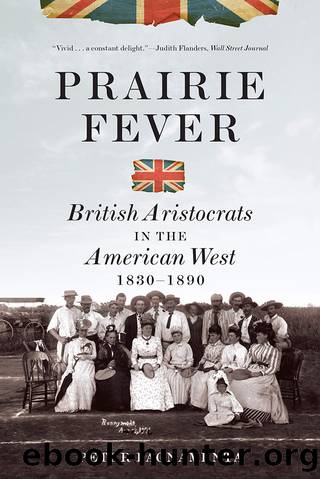Prairie Fever by Peter Pagnamenta

Author:Peter Pagnamenta [Pagnamenta, Peter]
Language: eng
Format: epub
Publisher: W. W. Norton & Company
Published: 2012-05-23T23:00:00+00:00
7
A Place for the Boys
They are, I understand, young gentlemen of high birth and some means. The peculiarly English passion for land-holding, and going forth shooting and to shoot, led them into this strange enterprise.
—GRACE GREENWOOD, 18731
A hundred years after the Declaration of Independence, the number of passengers crossing the Atlantic to the former colony was greater than ever. Most were still poor emigrants in steerage class, trying to escape from extreme poverty, or skilled workingmen with a craft to sell, hoping to better themselves. But by 1876, a significant number of well-to-do Britons were coming over as tourists. The United States, with its different society, continued to fascinate the mother country, and in an age when great international expositions represented the most compelling attractions that could be mounted, thousands came specially for that year’s Centennial fair in Philadelphia. The exhibition was larger than any of its predecessors held in London, Paris, and Vienna, and the British travel agent Thomas Cook judged it “a scene such as the world never before saw, nor is likely to be seen again.”2
Held in Fairmount Park on high ground on the western side of the Schuylkill River, a trolley ride from Chestnut Street and the old Statehouse where the Declaration of Independence had been signed, the Centennial was heavily promoted in Britain. After spending four or five days at the exhibition, many traveled on to see other parts of the country, including the Far West and California, on Cook’s tours that lasted up to three months. The cheapest return excursion from London to Philadelphia could be had for just over £20.
In the flag-decked, iron-framed halls, which stretched for over half a mile, the country’s new manufacturing might was on view, with avenues of gleaming railway engines and lines of black-enameled lathes, shuddering printing presses and hissing pumps. The machinery awed and alarmed British businessmen, who could see how rapidly the United States was emerging as a major rival. But it was the farm displays, from the latest reapers, hay loaders, and threshing machines to the pavilions in which individual states advertised their bountiful harvests, that impressed the aristocrats and country gentlemen who made their way there. Colorado and Kansas shared a soaring, cathedral-like pavilion, in the plan of a cross. From under the central dome hung a facsimile of Philadelphia’s Liberty Bell, formed entirely from ears of corn, with the bell’s clapper supplied by a six-foot-long gourd. While Colorado displayed gold quartz and silver ore, Kansas asserted its extraordinary fertility with sheaves of wheat six and a half feet high, and stalks of corn standing seventeen feet. In the fanned arrangements of produce, the brimming sacks of oats and barley, the glass vials of rich black earth, and the steeply angled lines charting record yields, visitors saw an updated vision of the American prairies. The perception of a wild natural landscape had been completely replaced by what promoters now called “the golden west.”
The proud displays at the Centennial Exposition came just as cheap American wheat was starting to be shipped to Britain.
Download
This site does not store any files on its server. We only index and link to content provided by other sites. Please contact the content providers to delete copyright contents if any and email us, we'll remove relevant links or contents immediately.
| Africa | Americas |
| Arctic & Antarctica | Asia |
| Australia & Oceania | Europe |
| Middle East | Russia |
| United States | World |
| Ancient Civilizations | Military |
| Historical Study & Educational Resources |
Underground: A Human History of the Worlds Beneath Our Feet by Will Hunt(11986)
Sapiens by Yuval Noah Harari(5270)
Navigation and Map Reading by K Andrew(4973)
The Sympathizer by Viet Thanh Nguyen(4269)
Barron's AP Biology by Goldberg M.S. Deborah T(4069)
5 Steps to a 5 AP U.S. History, 2010-2011 Edition (5 Steps to a 5 on the Advanced Placement Examinations Series) by Armstrong Stephen(3667)
Three Women by Lisa Taddeo(3329)
Water by Ian Miller(3093)
The Comedians: Drunks, Thieves, Scoundrels, and the History of American Comedy by Nesteroff Kliph(3011)
Drugs Unlimited by Mike Power(2523)
A Short History of Drunkenness by Forsyth Mark(2156)
The House of Government by Slezkine Yuri(2141)
DarkMarket by Misha Glenny(2128)
And the Band Played On by Randy Shilts(2091)
The Library Book by Susan Orlean(2026)
Revived (Cat Patrick) by Cat Patrick(1924)
The Woman Who Smashed Codes by Jason Fagone(1892)
The Absolutely True Diary of a Part-Time Indian by Sherman Alexie(1827)
The House of Rothschild: Money's Prophets, 1798-1848 by Niall Ferguson(1826)
